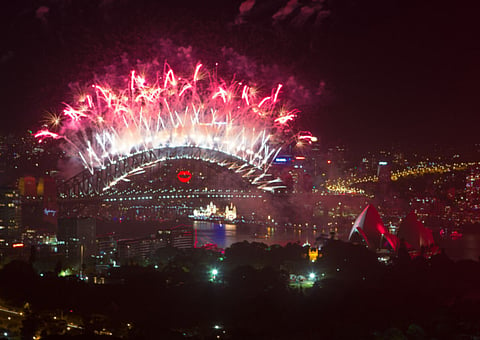Australia: fun all year round
Mark these dates, and profit from the right combination of music, art, food and nature

NOVEMBER
Considered the most vibrant horse racing event in the world, the Melbourne Cup Carnival (right) draws many visitors from Gulf countries. Although it begins in September, the carnival runs until mid-November, with the focal point being the 3,200-metre race for the Melbourne Cup. Described as the race that stops a nation, it is usually held on the first Tuesday in November.
If you prefer tennis, visit in January for the Australian Open, played out at Melbourne Park and one of the sport’s four Grand Slam events. Adrenaline junkies should attend the Melbourne Grand Prix in March.
Melbourne is consistently rated as one of the world’s best cities to live in, and is known for its culture, coffee and cool factor. The city’s obsession with racing is visible at the Melbourne Museum, where the preserved body of Phar Lap, a famous racehorse, is displayed. Other highlights include the National Gallery of Victoria, which has Australia’s largest art collection, the Eureka Skydeck, the highest viewing platform in the southern hemisphere, and for many people, the bars and clubs of the party-loving city’s central business district.
DECEMBER
The Christmas period in Australia occurs at the height of summer. In contrast to the fireside gatherings in the snowy northern hemisphere, the festive season here is spent outside — typically with a picnic on the beach where travellers from around the world swap gifts, enjoy a barbecue and go for a warm and refreshing swim. Carol singing by candlelight, sports contests, yacht races and world-class cultural events are some of the other highlights.
New Year’s Eve is also spent outdoors. Take your pick from riverside parties in Melbourne and Brisbane, park parties in Perth and Adelaide, and fireworks on the waterfront in Hobart and Sydney, where the world-class pyrotechnics off the Sydney Harbour Bridge (top) is considered the official start of the world’s New Year’s Eve celebrations.
FEBRUARY
As street parties go, Sydney’s Mardi Gras celebrations are famous all over the world. Spanning two weeks in February and March, the event is a colourful festival of diversity. Tens of thousands of people come to take part in and watch the Grand Parade float down Oxford Street, ending the day at the official Mardi Gras party. Other events that form a part of the A$30 million (about Dh104 million) event include a film festival, sporting races and Fair Day, an outdoor picnic that attracts 70,000 people.
Sydney is, of course, home to the famous Opera House and presents a packed calendar of events at any time of the year. In March and April, opera takes over Sydney Harbour, with the Opera House and the Harbour Bridge forming part of the backdrop for world-class productions. Also not to be missed are the Royal Botanic Gardens, Australia’s oldest, the famous Bondi Beach and The Rocks, Sydney’s old town.
JUNE
In recent years the Gold Coast has become synonymous with Ramadan in the antipodes. The Australian city has been home to Muslims since the 1930s, catering to the cultural and religious needs of halal tourists, and has been described as a beautiful example of harmony between nations. Ramadan lounges serving halal iftar meals are available for local and visiting Muslims, and Arabic-speaking staff are available at these venues. The city also has a host of halal butchers and halal restaurants serving Lebanese, Indian, Chinese, Malaysian and Thai food.
The Gold Coast is the capital of Queensland, where you can go diving at the Great Barrier Reef, sand skiiing in Tangalooma, and hiking in the national park of scenic Townsville, which is also home to the highest steep waterfall in Australia (above), located in Wallaman. Another must-see in June is the creative festival Vivid Sydney (bottom), which sees Sydney transformed into a canvas of light, music and ideas.
JULY
Desert lovers who appreciate camel races will already know about the Camel Cup at Blatherskite Park in the town Alice Springs, Northern Territory (below). First held in 1970 on a dry riverbed between two Lions Club members, the exciting and entertaining race is now an annual highlight in Australia’s events calendar.
The red desert town is also an important centre for Aboriginal art and adventure tourism, and six Australian languages are spoken here. Considered the real outback, the Northern Territory offers many highlights, including 52 national parks and 40,000 years of indigenous culture with rock art, spear fishing and bush tucker tastings.
SEPTEMBER
For something completely different, visit the capital city of Canberra and its 30-day spring festival, Floriade (below). Held during September and October, more than 400,000 visitors come to the themed event, as more than a million spring blooms present a riot of colour. Gourmet stalls, film screenings, exhibitions and concerts make this more than a flower show, but it is worth visiting for the beauty of nature alone.
Canberra is a planned city on the shores of the artificial Lake Burley Griffin and was named the capital city exactly 100 years ago. While its parliament buildings will attract history buffs, the War Memorial and Museum recount Australian military participation from Federation times to the present day. The National Dinosaur Museum and a miniature traditional English village at Cockington Green, both in Gold Creek Village, will be popular with children. Mountain trails, nature walks and boat rides are just some of the things to do here.
Sign up for the Daily Briefing
Get the latest news and updates straight to your inbox



